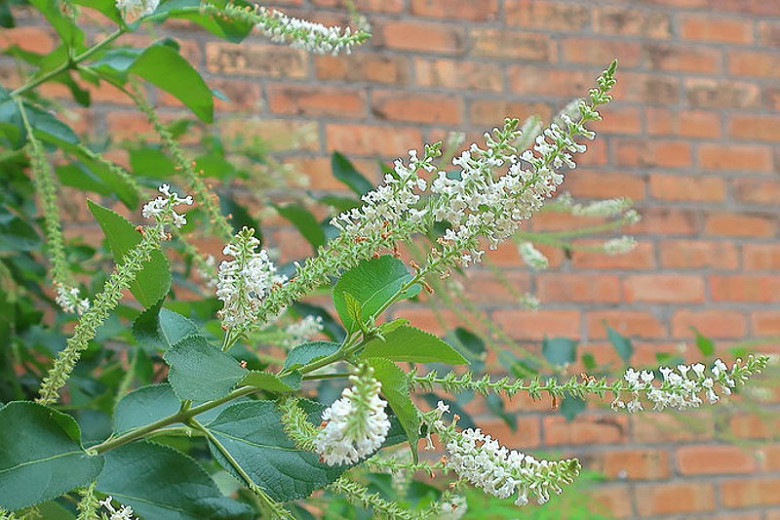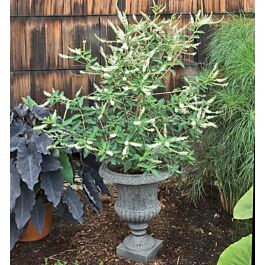The Sweet Almond Bush: A Fragrant And Droughttolerant Shrub For Your Garden
The sweet almond bush (Aloysia virgata) is a beautiful and fragrant shrub that is perfect for adding a touch of elegance to any garden. It is native to South America, but it can be grown in USDA hardiness zones 8-11. Sweet almond bushes are known for their long blooming period, which can last from midsummer to frost. They produce showy terminal spikes of white flowers that are incredibly fragrant. The flowers are also edible and can be used to make tea, syrup, or jelly.
In addition to their beauty and fragrance, sweet almond bushes are also drought-tolerant and relatively pest-free. They make a great choice for gardeners who live in hot, dry climates. Sweet almond bushes are also relatively easy to care for. They prefer full sun and well-drained soil. Water them regularly during the first year after planting, but once they are established, they can tolerate some drought. Prune them in early spring to encourage new growth and flowering.
Sweet almond bushes can be used in a variety of ways in the garden. They can be planted as single specimens, in borders, or as hedges. They can also be grown in containers. Sweet almond bushes are attractive to butterflies and other pollinators, so they can be a great addition to any garden that is designed to attract wildlife.
Here are some additional details about sweet almond bushes:
- Height and width: Sweet almond bushes can grow up to 15 feet tall and 8 feet wide. However, they can be easily pruned to keep them smaller.
- Soil: Sweet almond bushes prefer well-drained soil. They can tolerate some clay soil, but they will not do well in soggy soil.
- Watering: Sweet almond bushes need regular watering during the first year after planting. Once they are established, they can tolerate some drought. Water them deeply once a week during the summer months.
- Fertilizer: Sweet almond bushes do not need a lot of fertilizer. A light application of fertilizer in the spring will help them to bloom more profusely.
- Pests and diseases: Sweet almond bushes are relatively pest-free. However, they may be susceptible to scale insects and mealybugs. If you see any pests, you can treat them with insecticidal soap or neem oil.
- Propagation: Sweet almond bushes can be propagated by seed, stem cuttings, or air layering. Seed germination can be slow, so it is often easier to propagate them by stem cuttings or air layering.
If you are looking for a beautiful, fragrant, and drought-tolerant shrub for your garden, the sweet almond bush is a great choice. With its long blooming period and relatively easy care, the sweet almond bush is sure to add a touch of elegance to your garden for years to come.
Sweet almond bush, also known as Aloysia virgata, is a fast-growing woody shrub or small tree native to South America. It is prized for its long blooming and wonderfully scented flowers, which are white and appear in spikes from midsummer to frost. The foliage is evergreen in mild winter areas.
Sweet almond bush is a relatively easy plant to care for. It prefers full sun and well-drained soil. It is drought tolerant but will appreciate regular watering during the hot summer months. Sweet almond bush can be pruned to keep it in shape or to control its size.
If you are looking for a beautiful and fragrant shrub for your garden, sweet almond bush is a great option. For more information about sweet almond bush, please visit Garden Wiki.
FAQ of sweet almond bush
Question 1: What is a sweet almond bush?
Answer: A sweet almond bush is a deciduous shrub or small tree that is native to the Mediterranean region. It is known for its fragrant white flowers, which bloom in early spring. The sweet almond bush can grow up to 15 feet tall and has a spreading habit. It is hardy in USDA zones 7-10.
Question 2: How do I care for a sweet almond bush?
Answer: Sweet almond bushes are relatively easy to care for. They prefer full sun and well-drained soil. They should be watered regularly during the growing season, but they are drought-tolerant once established. Sweet almond bushes do not need to be fertilized often. A light application of fertilizer in the spring will help promote flowering.
Question 3: How do I propagate a sweet almond bush?
Answer: Sweet almond bushes can be propagated by seed, but they are more easily propagated by cuttings. To take a cutting, choose a healthy branch that is about 6 inches long. Make a clean cut just below a node. Remove the leaves from the bottom half of the cutting. Dip the cut end in rooting hormone and plant it in a pot of well-draining potting mix. Water the cutting well and place it in a warm, sunny location. The cutting should root in about 6-8 weeks.
Question 4: What are the uses of sweet almond bush?
Answer: Sweet almond bush has a number of uses. The flowers can be used to make perfume. The nuts can be eaten raw or roasted. The oil from the nuts can be used in cooking, cosmetics, and medicines. Sweet almond oil is a good source of vitamin E and has a number of health benefits, including moisturizing the skin, reducing inflammation, and improving circulation.
Question 5: What are the pests and diseases that affect sweet almond bush?
Answer: Sweet almond bush is susceptible to a number of pests and diseases, including aphids, scale insects, mealybugs, and almond rust. These pests can be controlled with insecticidal soap or neem oil. Almond rust is a fungal disease that can cause leaves to fall prematurely and reduce the yield of nuts. It can be controlled with fungicides.
Image of sweet almond bush
5 different images of "sweet almond bush" from Pinterest:
- Image 1: A sweet almond bush in full bloom, with its white flowers clustered together in small, fragrant bunches.

- Image 2: A close-up of the sweet almond bush's flowers, showing their delicate petals and bright yellow stamens.
- Image 3: A sweet almond bush in the fall, with its leaves turning a golden yellow color.

- Image 4: A sweet almond bush in winter, with its bare branches covered in snow.

- Image 5: A sweet almond bush in a pot, growing on a patio or balcony.


Post a Comment for "The Sweet Almond Bush: A Fragrant And Droughttolerant Shrub For Your Garden"